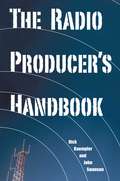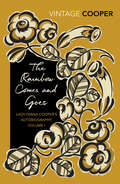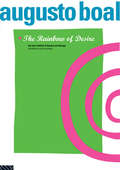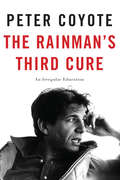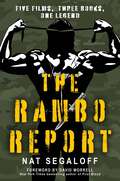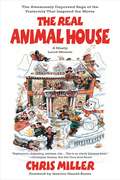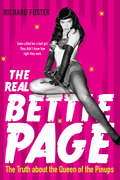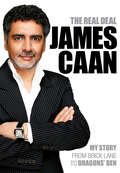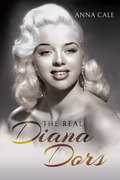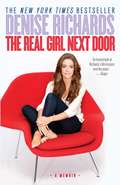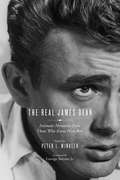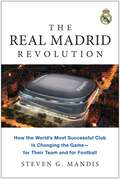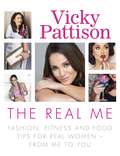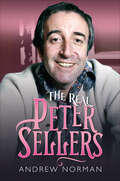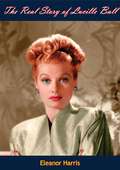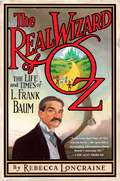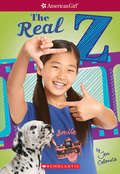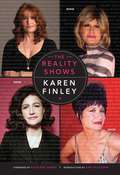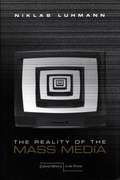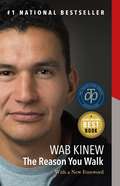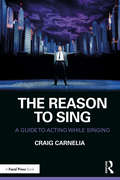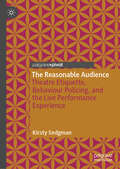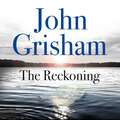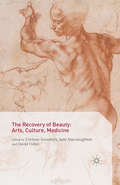- Table View
- List View
The Radio Producer's Handbook
by John Swanson Rick KaempferTwo award-winning major market producers present the definitive how-to guide for producing a radio show, explaining every duty a radio producer is expected to perform. With refreshing honesty and the humorous flair of professional radio comedy writers, the authors reveal how to get one's professional foot in the radio door, book celebrity guests, craft great interviews, come up with ideas, create great phone segments, write and pitch material, and cope with the pressure that accompanies producing a show in progress.
The Ragman's Son: An Autobiography
by Kirk DouglasRaised in poverty, longing for his father's approval, Issur Danielovitch went on to become a legendary Hollywood star - Kirk Douglas. Here in his own words is the story of his life.
The Rainbow Comes and Goes
by Diana CooperLady Diana Cooper was a star of the early twentieth stage, screen and social scene. This first instalment of her sparkling autobiography tells of her upbringing, her beautiful artistic mother and aristocratic father, her debut into high society and the glittering parties - 'dancing and extravagance and lashing of wine, and charades and moonlit balconies and kisses' - which were interrupted with the outbreak of the First World War. This volume ends with Diana's marriage to the 'love of her life', diplomat and politician Duff Cooper.
The Rainbow of Desire: The Boal Method of Theatre and Therapy
by Augusto BoalRainbow of Desire is a handbook of exercises with a difference. It is Augusto Boal's bold and brilliant statement about the therapeutic ability of theatre to liberate individuals and change lives. Now translated into English and comprehensively updated from the French, Rainbow of Desire sets out the techniques which help us `see' for the first time the oppressions we have internalised. Boal, a Brazilian theatre director, writer and politician, has been confronting oppression in various forms for over thirty years. His belief that theatre is a means to create the future has inspired hundreds of groups all over the world to use his techniques in a multitude of settings. This, his latest work, includes such exercises as: * The Cops in the Head and their anti-bodies * The screen image * The image of the future we are afraid of * Image and counter-image ....and many more. Rainbow of Desire will make fascinating reading for those already familiar with Boal's work and is also completely accessible to anyone new to Theatre of the Oppressed techniques.
The Rainman's Third Cure: An Irregular Education
by Peter Coyote"The rainman gave me two curesAnd he said, 'Just jump right in.'The one was Texas MedicineAnd the other was railroad gin.And like a fool I mixed themAnd they strangled up my mindNow people just get uglierAnd I have no sense of time." --Bob Dylan, "Stuck Inside of Mobile with the Memphis Blues Again" The guiding metaphor in Peter Coyote's new spiritual biography is drawn from a line in an early Bob Dylan song. For Coyote, the twin forces Dylan identifies as Texas Medicine and Railroad Gin - represent the competing forces of the transcendental, inclusive, and ecstatic world of love with the competitive, status-seeking world of wealth and power. The Rainman's Third Cure is the tale of a young man caught between these apparently antipodal options and the journey that leads him from the privileged halls of power to Greenwich Village jazz bars, to jail, to the White House, lessons from a man who literally held the power of life and death over others, to government service and international success on stage and screen.Expanding his frame beyond the wild ride through the 1960's counterculture that occupied so much of his lauded debut memoir, Sleeping Where I Fall, Coyote provides readers intimate portraits of mentors that shaped him-a violent, intimidating father, a be-bop Bass player who teaches him that life can be improvised, a Mafia consiglieri, who demonstrates to him that men can be bought and manipulated, an ex game-warden who initates him into the laws of nature, a gay dancer in Martha Graham's company who introduces him to Mexico and marijuanas, beat poet Gary Snyder, who introduces him to Zen practice, and finally famed fashion designer Nino Cerruti who made the high-stakes world of haute monde Europe available to him.What begins as a peripatetic flirtation with Zen deepens into a life-long avocation, ordination as a priest, and finally the road to Transmission---acknowledgement from his teacher that he is ready to be an independent teacher. Through Zen, Coyote discovers a third option that offers an alternative to both the worlds of Love and Power's correlatives of status seeking and material wealth. Zen was his portal, but what he discovers on the inside is actually available to all humans. In this energetic, reflective and intelligent memoir, The Rainman's Third Cure is the way out of the box. The way that works.
The Rambo Report: Five Films, Three Books, One Legend
by Nat SegaloffThe ultimate guide to the Rambo phenomenon—from bestselling novel to Hollywood blockbuster to all-American hero, legend, and icon—written with the full cooperation of Rambo&’s creator, bestselling author David Morrell . . . From the beginning, Rambo was more than a character in a 1972 novel by David Morrell. He was the culmination of the author&’s personal encounters with veterans returning from the Vietnam War. The 1982 movie adaptation of First Blood reflected the novel&’s powerful insights into a troubled veteran&’s postwar experience. Then in 1985, the film&’s explosive sequel Rambo: First Blood Part II transformed the character into something shockingly different. With a focus on blood-and-guts action—and the beefed-up muscles of Sylvester Stallone—Rambo became an invincible one-man army. A new kind of hero for a new day in America. A full-blown pop-culture icon as controversial as he was crowd-pleasing—blasting his way through the most influential action film franchise in Hollywood history . . . The Rambo legend was born. Five feature films. Three novels. Seven video games. Countless comic books, action figures, and even an animated TV show for kids. The Rambo machine has been as unstoppable as Rambo himself. Now for the first time, Hollywood insider Nat Segaloff digs deep into the man, the myth, and the massive impact of the phenomenon known as &“The Rambo Effect.&” Packed with behind-the-scenes anecdotes, sharp cultural insights, and ongoing debates about violence in the media, this is an explosive no-holds-barred report from the front lines of Hollywood mythmaking. A must-read for Rambo fans, movies buffs, and anyone interested in American culture . . .
The Real Animal House: The Awesomely Depraved Saga of the Fraternity That Inspired the Movie
by Chris Miller"Loud, raucous, infantile, racy, and very funny...The book is full of likable eccentrics, sexual shenanigans, and--if you know where to look for them--valuable life lessons."--Booklist Animal House, the movie, didn't tell the half of it. Writing with a freshness and joy that make Dartmouth 1960 feel like a beer-soaked rock-and-roll heaven on earth, Chris Miller tells the real story of the Alpha Delta Phi fraternity as no one else could. Seal, Doberman, Otter, the legendary Moses (he of the burning bush) - these titans and dozens of others come alive again, terrorizing the administration, taunting cops, surviving their own lunacy, and challenging the squareness of a stifling time. The Real Animal House is the perfect antidote for a conventional age much like today. "A breezy, chuckle-worthy read, and a must for the Animal House fan." -Courier-Post "Action-packed. . . . A boozy holler of a book, with a great soundtrack." -Kirkus Reviews "A seriously funny read. . . . The joy and exuberance that Pinto and his pals demonstrate holds a lesson for every generation that needs to learn not to blindly follow the expectations of parents and guidance counselors, but to seek out those blissful bands of merry misfits that appear from time to time." -Review
The Real Bettie Page: The Truth about the Queen of the Pinups
by Richard Foster“Scrupulously researched . . . An eloquent fan, Foster brings insight into Page’s recent revival as a sex symbol.” —Entertainment Weekly TWENTIETH ANNIVERSARY EDITION UPDATED BY THE AUTHOR WITH A NEW EPILOGUE She has been called the most photographed model in history. From her modest beginnings in Nashville to her legacy as a cult figure, here is the true story of America’s iconic pinup queen, legendary Playboy centerfold Bettie Page—including her stormy marriages, her trial for attempted murder, and her decade-long isolation in a California mental institution. During the 1950s, Bettie set hearts ablaze with her killer curves and girl-next-door smile. Yet at the height of her popularity, with a promising acting career before her, she walked away. For more than thirty years, Bettie stayed hidden from the public eye, though she lived on in her fans’ memories, much like Marilyn Monroe and James Dean. Journalist Richard Foster became the first reporter to contact Page during her long absence, and the first to tell her full story. Using interviews with those who knew her, and filled with uncommon knowledge and insights, The Real Bettie Page reveals both the fun flirt and fashion-forward counter-culture icon whose style continues to inspire today, as well as the intriguing and complex, flesh-and-blood woman behind her smiling photos. Includes classic and rare color and black-and-white photos
The Real Deal: My Story from Brick Lane to Dragons' Den
by James CaanAfter dropping out of school at just sixteen, James Caan started his business life in a broom cupboard with no qualifications and two pieces of fatherly wisdom: 'observe the masses and do the opposite' and 'always look for opportunities where both parties benefit'. Armed with this advice, natural charm and the Yellow Pages, he built a market-leading business with a turnover of £130 million and swiftly became one of Britain's most successful entrepreneurs.From Caan's childhood as a Pakistani immigrant to the phenomenal success of his first company and beyond, The Real Deal traces both his financial and personal achievements. It offers a frank account of what success at thirty really signifies and brings us right up to the present, including his impact on Dragons' Den and what his charity work, from saving a hospital in London to building a school in Lahore, means to him. Ultimately, it is a story of learning what money is really worth, told by one the country's most insightful businessmen.
The Real Diana Dors
by Anna CaleThe true story of the tumultuous and too-short life of the film star known as &“the English Marilyn Monroe.&” The story of Diana Dors is one of fame, glamour, and intrigue. From the moment she came into the world, her life was full of drama. She began her acting career in the shadow of the Second World War, entering the film world as a vulnerable young teenager and negotiating the difficult British studio system of the 1940s and &’50s. Yet she battled against the odds to become one of the most iconic British actors of the twentieth century. This book follows her remarkable story, from childhood in suburban Swindon to acting success as a teenager and finding fame as the &“the English Marilyn Monroe.&” Many remember her as an outspoken and sometimes controversial figure, grabbing headlines for her personal life as often as for her film roles. For Diana, image seemed to be everything, but there was more to her than the blonde-bombshell reputation suggested. A talented actor, she worked on numerous film and television projects, building a career that spanned decades. Set against the backdrop of the changing social landscape of twentieth century Britain, this book charts the ups and downs of her professional adventures and her tumultuous private life, to build a fascinating picture of a unique screen icon.
The Real Girl Next Door: A Memoir
by Denise RichardsIT’S COMPLICATED. We’ve read the scandalous headlines, watched her sexy breakout performances in Starship Troopers and Wild Things, and seen her many public faces on her reality television show—the beautiful vixen, the devoted mother, the hard-working entertainer, and the fun-loving friend. But how well do we really know Denise Richards? Like so many small-town girls, she dreamed of making it big in Hollywood. But following a painful, high-profile divorce from Charlie Sheen, she found herself raising their two young daughters alone as her mother was dying of cancer. Denise writes openly and honestly about these experiences and more: she lets you in on her childhood dreams, her fated move to Hollywood with her close-knit family, her rise to fame, the pressures of living in the spotlight, and the controversy surrounding her relationships. Through it all, she managed to keep her sense of humor and optimism. She offers an up-close and personal look at her most intimate battle scars and the lessons she’s learned as she’s healed and grown. Denise’s story will resonate with anyone who has had to look within herself to find strength and courage when life is throwing curveballs. Inspiring and uplifting, raw and revealing, Denise finally lets her fans in on the resilient woman behind the bombshell persona, the person her friends and family already know: The Real Girl Next Door.
The Real James Dean: Intimate Memories from Those Who Knew Him Best
by Peter Winkler George StevensIn the decades following his death, many of those who knew James Dean best--actors, directors, friends, lovers (both men and women), photographers, and Hollywood columnists--shared stories of their first-person experiences with him in interviews and in the articles and autobiographies they wrote. Their recollections of Dean became lost in fragile back issues of movie magazines and newspapers and in out-of-print books that are extremely hard to find. Until now. The Real James Dean is the first book of its kind: a rich collection spanning six decades of writing in which many of the people whose lives were touched by Dean recall their indelible experiences with him in their own words. Here are the memorable personal accounts of Dean from his high school and college drama teachers; the girl he almost married; costars like Rock Hudson, Natalie Wood, Jim Backus, and Raymond Massey; directors Elia Kazan, Nicholas Ray, and George Stevens; entertainer Eartha Kitt; gossip queen Hedda Hopper; the passenger who accompanied Dean on his final, fatal road trip; and a host of his other friends and colleagues.
The Real Madrid Revolution: How the World's Most Successful Club Is Changing the Game—for Their Team and for Football
by Steven G. MandisReal Madrid&’s innovative, modern strategies may not only keep them on top—but save soccer itself. Featuring behind-the-scenes coverage and expert analysis, this book gives fans an up close and personal look at one of the world&’s most legendary teams during a major crossroads for the sport. Former Columbia Business School adjunct professor Steven G. Mandis, who analyzed Real Madrid&’s path to success in The Real Madrid Way, returns to examine how the club is coping with systemic changes in the sport of soccer and innovating the sport in the process. Founded in 1902 and granted a royal title by the king of Spain in 1920, Real Madrid Club de Fútbol went onto become the world&’s most valuable sports team (by revenue), most popular sports team (by social media followers), and most successful sports team (by number of trophies). But today, this legendary, member-owned soccer team faces significant challenges, including: Soccer losing the global entertainment battle against other sports and platforms The proliferation of closely government-related, private equity, and multi-club ownership models—while Real Madrid are a not-for-profit club owned by 92,000 members The financial dominance and further separation of the English Premier League, the so-called &“NBA of football&” The conflicts of FIFA and UEFA being both regulators and hosts of tournaments A more congested schedule, leading to a glut of matches and more player injuries Players who earn more from endorsements than from playing the game An explosion of media platforms that enable a young generation of global fans to watch and engage with sports and entertainment in new and nontraditional ways With their top-tier status, not to mention the supremacy of their sport, hanging in the balance, Real Madrid&’s trademark passion and values have never been more important. The Real Madrid Revolution showcases what it takes to stay on top when external forces are not working your favor—and how to innovate to be stronger than ever.
The Real Me: Fashion, Fitness and Food Tips for Real Women – From Me to You
by Vicky Pattison'I believe in grafting hard, training right, eating well . . . and having a good time!'WORK HARDVicky Pattison knows that achieving your dreams takes hard work, hustle, a sense of humour and a killer outfit. And now she's sharing her insider secrets for the first time: how to dress for success, how to eat well and keep healthy on the go and how to stay true to yourself when the going gets tough.PLAY HARDBut Vicky wouldn't be Vicky if she didn't also know how to cut loose and have fun. The Real Me has everything you and your squad need for an epic night out or the ultimate girls' night in. And for the morning after, there's honest and hilarious advice on curing a hangover . . . and a broken heart.The Real Me is packed with recipes, fashion and beauty tips, training programmes and straight-talking advice on dealing with everything from job interviews to first dates. This is the ultimate guide to living life to the full, the Vicky Pattison way.'I'm finally proud of myself and happy with who I am inside and out, and I want every woman in the world to feel like that too.' Vicky x
The Real Peter Sellers
by Andrew NormanThroughout the world, people regard Peter Sellers purely as a comedic genius: surely, one of the greatest ever to have lived. But, the astute observer will notice that he always appeared to be acting, even when being interviewed. So, who was Peter Sellers? Sellers once said, ‘I could never be myself you see. There is no “Me”. I do not exist. There used to be me, but I had it surgically removed’. Clearly, this was not intended to be taken literally. Instead, the inference is that somehow, he had lost his sense of identity. To discover the real Peter Sellers is no easy task, and when we do, what we encounter is a totally different persona from the comedic characters that he portrayed on the screen. Sellers had celebrity status: a succession of beautiful wives; immense wealth; magnificent motor cars; expensive yachts; a house in Mayfair, and various palatial residences. But far from being happy, he was plagued by self-doubt; ambitious, but never satisfied. And so, he resorted to superstition, clairvoyance, and drugs to get himself through the day. For all Sellers’ worldwide fame as ‘Inspector Clouseau’, many regard the film Being There, in which he played the character ‘Chance’, a gardener, as his masterpiece. In fact, the film was a damning indictment of the false god of materialism. Sellers’ obsession with the character of ‘Chance’, makes it seem likely that this was the kind of person he aspired to be, and wished that he had been.
The Real Story of Lucille Ball
by Eleanor HarrisThe difficult early years…The truth about her and Desi…What’s behind I Love Lucy…First published in 1954, this is the full story of the actress who struggled to achieve stardom in the savagely competitive world of Hollywood and then went on to top place in television. And the story of the woman who won the harder battle of preserving the things she loved—marriage, home, and family—against the unceasing demands of success.
The Real Wizard of Oz: The Life and Times of L. Frank Baum
by Rebecca LoncraineIn the first major literary biography of L. Frank Baum, Rebecca Loncraine tells the story of Oz as you've never heard it, with a look behind the curtain at the vivid life and eccentric imagination of its creator.L. Frank Baum wrote The Wonderful Wizard of Oz in 1899 and it was first published in 1900. A runaway hit, it was soon recognized as America's first modern fairy tale. Baum's life story, like the fictional world he created, is uniquely American, rooted in the transforming historical changes of his times. Baum was a complex and eccentric man who could never stay put for long; his restless creative spirit and voracious appetite for new projects led him across the U.S. during his lifetime, and he drew energy and inspiration from each new dramatic landscape he encountered,. Born in 1856, Baum spent his youth in the Finger Lakes region of New York as amputee soldiers returned from the Civil War; childhood mortality was also commonplace, blurring the lines between the living and the dead, and making room in Baum's young imagination for vividly real ghosts. When Baum was growing up, P. T. Barnum ruled the minds of small towns and his traveling circus was the most famous act around. Baum married a headstrong young woman named Maud Gage and they ventured out west to Dakota Territory, where they faced violent tornadoes, Ghost Dancing tribes and desperate droughts, before trading the hardships on the Great Plains for the excitement of Chicago and the fantastical White City of the World's Fair.Baum's writing tapped into an inner world that blurred his own sense of reality and fantasy. The Land of Oz, which Baum believed he had "discovered" rather than invented, grew into something far bigger and more popular than he'd ever imagined. After the roaring success of The Wonderful Wizard of Oz in 1900, he became a kind of slave to his creation, trapped inside Oz as his army of demanding child fans kept sending him back there to create new adventures for Dorothy, Toto and the humbug wizard. He went on to write thirteen sequels to his first Oz book. He also wrote the first Broadway adaptations of his Oz tales, and turned his Oz books into some of the first motion pictures in a small and undiscovered rural settlement called "Hollywood". Baum co-founded the Oz Film Manufacturing Company, even as critics warned that no one would pay to see a children's story. And they were right- his early ventures were box office flops and the world was not ready for Oz on screen until 1939, when MGM released "The Wizard of Oz" in brilliant Technicolor. Baum was not around to see it-he'd died in bed in 1919 just weeks after completing his final Oz book. But the book and film alike have become classics, just as well-loved today as they were when they first appeared.The Real Wizard of Oz is an imaginatively written work that stretches the genre of biography and enriches our understanding of modern fairytales. L. Frank Baum, author of The Wonderful Wizard of Oz and its thirteen sequels, lived during eventful times in American history-- from 1856 to 1919-- that influenced nearly every aspect of his writing, from the Civil War to Hollywood, which was emerging as a modern Emerald City full of broken dreams and humbug wizards, to the gulf between America's prairie heartland, with its wild tornadoes, and its cities teeming with "Tin Man" factory workers. This is a colorful portrait of one man's vivid and eccentric imagination and the world that shaped it. Baum's famous fairytale is filled with the pain of the economic uncertainties of the Gilded Age and with a yearning for real change, ideas which many contemporary Americans will recognize. The Wizard of Oz continues to fascinate and influence us because it explores universal themes of longing for a better world, homesickness and finding inner strength amid the storms.
The Real Z: Z Yang, Book 1) (American Girl: Z Yang #1)
by Jen CalonitaAnd action! Z knows what she's doing when it comes to making movies. She's an expert at stop-motion video. In this first book about the aspiring filmmaker, Z has to make a whole new kind of movie--a documentary--and it's harder than she thought. Z wants to wow the judges, but she's not sure her ideas are good enough for a film festival. With the help of her friends, Z shoots a lot of footage, but something about it doesn't feel right. Should she start over? As she tries to make a movie she can be proud of, Z discovers that to be a real filmmaker, she'll first have to be her real self.
The Reality Shows
by Ann Pellegrini Karen Finley Kathleen Hanna"Ms. Finley hasn't lost the power to disturb."-Ben Brantley, The New York TimesNo other contemporary performing artist has captured the psychological complexity of this decade's political and social milestones as Karen Finley has in the past ten years. In her inimitable style, Finley has embodied some of the most troubling figures to cast a long shadow on the public imagination, and has envisioned a kind of catharsis within each drama: Liza Minnelli responds to the September 11 attacks; Terri Schaivo explains why Americans love a woman in a coma; Martha Stewart dumps George W. Bush during their tryst on the eve of the Republican National Convention; Silda Spitzer tells the former governor why "I'm sorry" just isn't enough; Jackie O cries, "Please stop looking at me!"The Reality Shows is a revelation of a decade by one of our greatest interpreters of popular and political culture.Karen Finley's raw and transgressive performances have long provoked controversy and debate. She has appeared and exhibited her visual art, performances, and plays internationally. The author of many books, including A Different Kind Of Intimacy, George & Martha, and Shock Treatment, she is a professor at the Tisch School of Art and Public Policy at NYU.Kathleen Hanna, activist and writer, was the lead singer of the punk band Bikini Kill before fronting the dance-punk band Le Tigre. She released a solo album under the name Julie Ruin.
The Reality of the Mass Media (Cultural Memory in the Present)
by Niklas Luhmann Kathleen Cross<p>In The Reality of the Mass Media, Luhmann extends his theory of social systems—applied in his earlier works to the economy, the political system, art, religion, the sciences, and law—to an examination of the role of mass media in the construction of social reality. <p>Luhmann argues that the system of mass media is a set of recursive, self-referential programs of communication, whose functions are not determined by the external values of truthfulness, objectivity, or knowledge, nor by specific social interests or political directives. Rather, he contends that the system of mass media is regulated by the internal code information/noninformation, which enables the system to select its information (news) from its own environment and to communicate this information in accordance with its own reflexive criteria. <p>Despite its self-referential quality, Luhmann describes the mass media as one of the key cognitive systems of modern society, by means of which society constructs the illusion of its own reality. The reality of mass media, he argues, allows societies to process information without destabilizing social roles or overburdening social actors. It forms a broad reservoir (memory) of options for the future coordination of action, and it provides parameters for the stabilization of political reproduction of society, as it produces a continuous self-description of the world around which modern society can orient itself. <p>In his discussion of mass media, Luhmann elaborates a theory of communication in which communication is seen not as the act of a particular consciousness, nor the medium of integrative social norms, but merely the technical codes through which systemic operations arrange and perpetuate themselves.</p>
The Reason You Walk
by Wab KinewA moving story of father-son reconciliation told by a charismatic aboriginal starWhen his father was given a diagnosis of terminal cancer, Winnipeg broadcaster and musician Wab Kinew decided to spend a year reconnecting with the accomplished but distant aboriginal man who'd raised him. The Reason You Walk spans that 2012 year, chronicling painful moments in the past and celebrating renewed hopes and dreams for the future. As Kinew revisits his own childhood in Winnipeg and on a reserve in Northern Ontario, he learns more about his father's traumatic childhood at residential school. An intriguing doubleness marks The Reason You Walk, itself a reference to an Anishinaabe ceremonial song. Born to an Anishinaabe father and a non-native mother, he has a foot in both cultures. He is a Sundancer, an academic, a former rapper, a hereditary chief and an urban activist. His father, Tobasonakwut, was both a beloved traditional chief and a respected elected leader who engaged directly with Ottawa. Internally divided, his father embraced both traditional native religion and Catholicism, the religion that was inculcated into him at the residential school where he was physically and sexually abused. In a grand gesture of reconciliation, Kinew's father invited the Roman Catholic bishop of Winnipeg to a Sundance ceremony in which he adopted him as his brother. Kinew writes affectingly of his own struggles in his twenties to find the right path, eventually giving up a self-destructive lifestyle to passionately pursue music and martial arts. From his unique vantage point, he offers an inside view of what it means to be an educated aboriginal living in a country that is just beginning to wake up to its aboriginal history and living presence. Invoking hope, healing and forgiveness, The Reason You Walk is a poignant story of a towering but damaged father and his son as they embark on a journey to repair their family bond. By turns lighthearted and solemn, Kinew gives us an inspiring vision for family and cross-cultural reconciliation, and for a wider conversation about the future of aboriginal peoples.
The Reason to Sing: A Guide to Acting While Singing
by Craig CarneliaIn The Reason to Sing, renowned composer-lyricist and teacher Craig Carnelia provides musical actors with a step-by-step guide to making their singing performances more truthful, vivid, and full of life. Using a technique developed over decades of teaching the professional community of Broadway actors and students alike, The Reason to Sing utilizes detailed descriptions of sessions the author has had with his notable students and lays out a new and proven approach to help you build your skills, your confidence, and your career. This book is intended for musical theater acting students as well as working professionals and teachers of the craft.
The Reasonable Audience: Theatre Etiquette, Behaviour Policing, And The Live Performance Experience
by Kirsty SedgmanAudiences are not what they used to be. Munching crisps or snapping selfies, chatting loudly or charging phones onstage – bad behaviour in theatre is apparently on the rise. And lately some spectators have begun to fight back…The Reasonable Audience explores the recent trend of ‘theatre etiquette’: an audience-led crusade to bring ‘manners and respect’ back to the auditorium. This comes at a time when, around the world, arts institutions are working to balance the traditional pleasures of receptive quietness with the need to foster more inclusive experiences. Through investigating the rhetorics of morality underpinning both sides of the argument, this book examines how models of 'good' and 'bad' spectatorship are constructed and legitimised. Is theatre etiquette actually snobbish? Are audiences really more selfish? Who gets to decide what counts as ‘reasonable’ within public space?Using theatre etiquette to explore wider issues of social participation, cultural exclusion, and the politics of identity, Kirsty Sedgman asks what it means to police the behaviour of others.
The Reckoning: The Sunday Times Number One Bestseller
by John GrishamThe electrifying new thriller from internationally bestselling author John Grisham.John Grisham returns to Clanton, Mississippi, to tell the story of an unthinkable murder, the bizarre trial that followed it, and its profound and lasting effect on the people of Ford County.Pete Banning was Clanton's favourite son, a returning war hero, the patriarch of a prominent family, a farmer, father, neighbour, and a faithful member of the Methodist Church. Then one cool October morning in 1946. he rose early, drove into town, walked into the church, and calmly shot and killed the Reverend Dexter Bell.As if the murder wasn't shocking enough, it was even more baffling that Pete's only statement about it - to the sheriff, to his defense attorney, to the judge, to his family and friends, and to the people of Clanton - was 'I have nothing to say'.And so the murder of the esteemed Reverend Bell became the most mysterious and unforgettable crime Ford County had ever known.Praise for Grisham's latest book, The Rooster Bar'Scintillating storytelling' - The Sunday Times'A buoyant, mischievous thriller . . . This reliable best-selling author is feeling real pleasure, and not just obligation, in delivering his work' - New York Times(P)2018 Random House Audio
The Recovery of Beauty: Arts, Culture, Medicine
by David Fuller Corinne SaundersAn interdisciplinary collection of essays exploring the complex and conflicted topic of beauty in cultural, arts and medicine, looking back through the long cultural history of beauty, and asking whether it is possible to 'recover beauty'.
